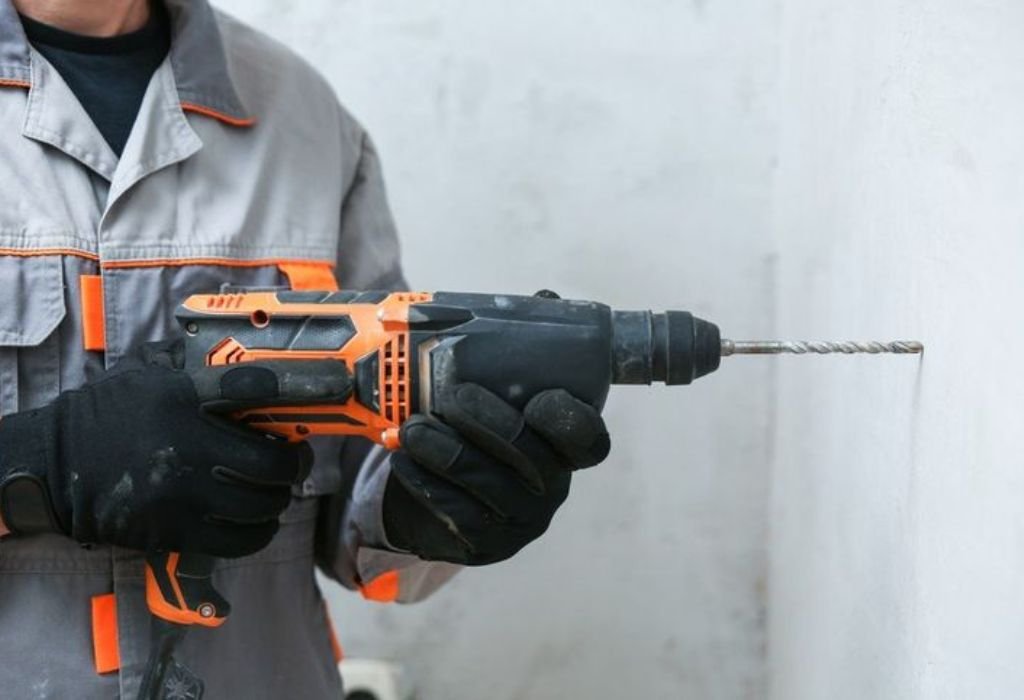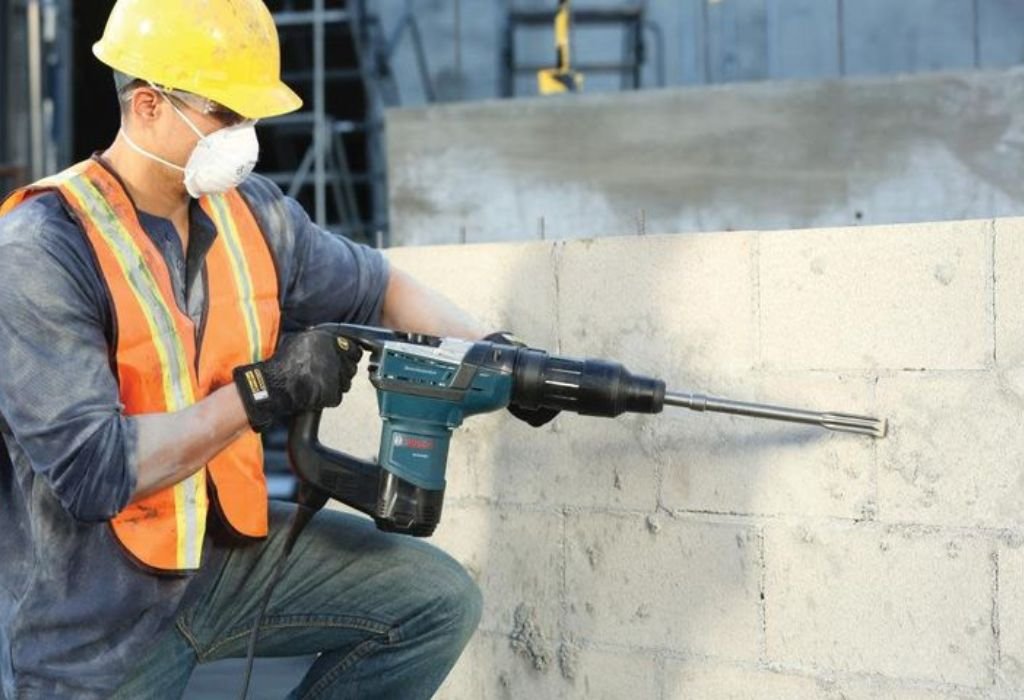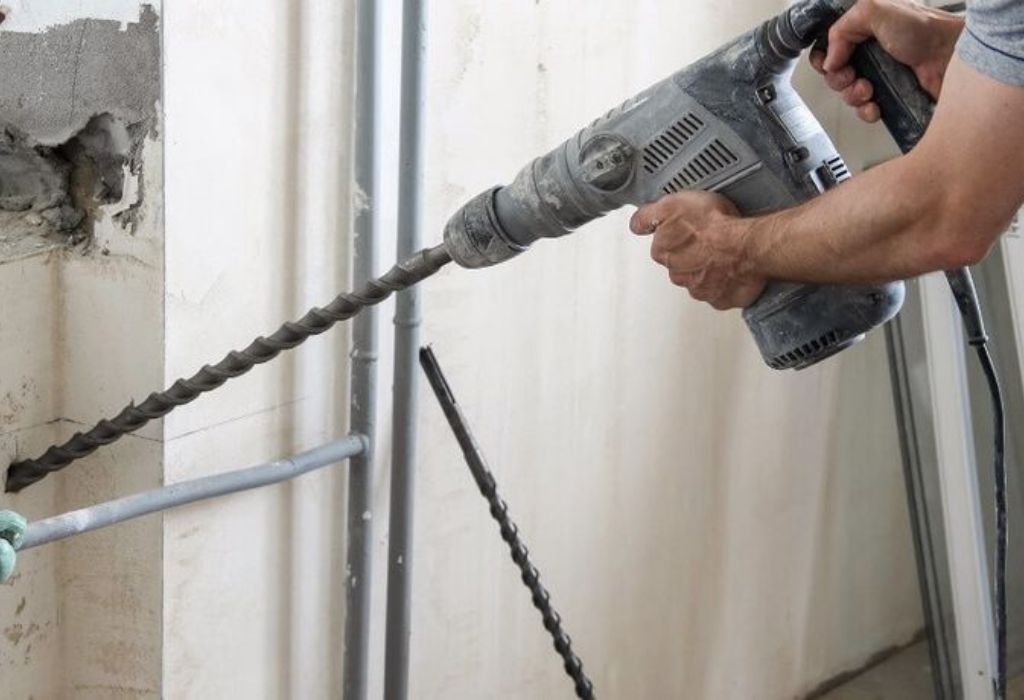The bit locks suddenly inside the concrete, and the drill twists violently in the operator’s hands.
In that instant, what seemed like a routine task becomes a dangerous situation that can lead to serious injury.
Rotary hammer drills are designed to combine rotation with a powerful hammering action, allowing them to bore through concrete, stone, and masonry.
This strength also introduces unique hazards such as kickback, dust inhalation, noise exposure, and long-term vibration effects.
Many users ask the same question before picking one up: how dangerous are rotary hammer drills to operate.
The risks are real, but understanding them is the first step toward preventing accidents and improving job-site safety.
According to the Centers for Disease Control and Prevention, hand and power tools are a frequent cause of workplace injuries, often resulting from misuse or lack of protective equipment (CDC/NIOSH).
Prolonged exposure to vibration can also contribute to hand-arm vibration syndrome (HAVS) and other health issues if precautions are ignored (HSE).
Despite these concerns, the dangers are manageable.
Modern rotary hammers include features like slip clutches, anti-rotation systems, and vibration control, which reduce the likelihood of accidents. When combined with correct technique, proper setup, and personal protective equipment, these tools can be used safely even in demanding conditions.
This guide explores the real risks of rotary hammer drills, the technologies that reduce those risks, and the best practices that protect both professionals and DIY users.
By the end, readers will understand not only the hazards but also the solutions that make drilling safer and more efficient.
What a Rotary Hammer Drill Is and Why Risk Exists

A rotary hammer drill is a specialized power tool built to bore into tough materials like concrete, stone, and brick. It uses a piston-driven mechanism that combines rotation with powerful hammering action to achieve fast penetration where standard drills would fail.
The efficiency of these tools also creates unique risks. High torque, vibration, and impact force can make them difficult to control, especially when the bit binds unexpectedly in dense material.
Rotary hammer drills typically use SDS-Plus or SDS-Max bit systems, which allow bits to slide and hammer while remaining locked in place. These systems increase performance but also amplify the torque transferred to the operator if a stall occurs.
When used incorrectly or without safety features, these drills can cause sudden kickback, wrist injuries, and debris hazards. Understanding their design is key to using them safely and reducing the dangers of operation.
How does a rotary hammer differ from a hammer drill?
A rotary hammer uses a piston-driven impact system, while a hammer drill relies on a mechanical clutch for lighter-duty work.
What does SDS mean?
SDS stands for “Slotted Drive System,” a bit design that ensures stability and efficient hammering action.
Where do most accidents happen?
Incidents often occur when the bit strikes rebar, binds in the hole, or is used at the wrong speed or pressure.
Is tool size a factor in risk?
Yes, larger SDS-Max drills deliver greater torque and require stronger control and handling.
Does cordless technology reduce danger?
No, modern cordless drills match corded power levels, so hazards like kickback and vibration remain.
How Dangerous Are Rotary Hammer Drills to Operate? Key Hazards
The dangers of rotary hammer drills are linked to their power. While effective for heavy-duty tasks, they can create multiple risks if not managed carefully.
Kickback is the most common hazard. When the bit binds, the torque can twist the tool suddenly and cause hand, wrist, or shoulder injuries.
Debris ejected from the hole can cause serious eye damage. Concrete dust is another issue, carrying silica particles that can harm lungs if inhaled.
Noise and vibration exposure are also significant. Extended use without protection can lead to hearing loss and vibration-related injuries.
What causes sudden tool twist?
A bound bit creates torque spikes that can throw the drill off balance.
Can debris cause eye injuries?
Yes, high-speed fragments can damage unprotected eyes.
Is dust a health hazard?
Yes, silica dust exposure is linked to lung diseases and requires controls.
Does vibration matter on short jobs?
Even brief use contributes to cumulative damage over time.
Is corded safer than cordless?
No, both produce similar risks depending on control and setup.
Safety Technologies That Reduce Danger
Manufacturers now equip rotary hammers with built-in safety features. These systems drastically reduce accidents when used correctly.
Slip clutches disengage the drive when torque exceeds safe limits. This prevents the drill from wrenching violently when the bit stalls.
Electronic anti-rotation or kickback control sensors cut power if sudden twisting is detected. This makes a huge difference in operator safety.
Other features include vibration-dampening handles, soft-start motors, and braking systems. All of these enhance stability and reduce operator fatigue.
What does a slip clutch do?
It disengages the gear drive when the bit binds.
How does anti-rotation work?
Sensors detect over-rotation and stop power instantly.
When to use hammer-only mode?
For chiseling tasks where rotation is unnecessary.
Do anti-vibration handles help?
Yes, they reduce fatigue and improve control.
Is a side handle necessary?
Yes, always use the auxiliary handle for leverage and stability.
Setup That Prevents Accidents Before You Drill

Accident prevention starts before the drill touches the surface. Proper preparation reduces risks significantly.
Inspect the work material and check for embedded rebar using a scanner. Choose the right SDS bit for the material and hole size.
Always wear personal protective equipment including glasses, hearing protection, gloves, and a dust mask or respirator. Secure the work area to prevent slips and interruptions.
Regular tool checks matter as well. Damaged cords, worn chucks, or dull bits increase risks dramatically.
Which bit reduces binding?
Sharp, properly sized SDS bits with clean flutes.
How to avoid hitting rebar?
Use rebar detection scanners or review updated plans.
What PPE is essential?
Eye protection, ear protection, respirators, gloves, and boots.
Should the workpiece be secured?
Yes, movement increases accident risks.
Do dull bits raise danger?
Yes, dull bits create more binding and heat.
Technique: The Safest Way to Run a Rotary Hammer
Even the best safety features can’t replace good technique. Proper handling is the foundation of safe operation.
Maintain a balanced stance with both hands firmly on the tool. Start slowly with light pressure until the bit is properly engaged.
Let the hammer action do the work. Excessive force only increases the risk of binding and kickback.
If the bit binds, release the trigger immediately. Do not fight the torque—reset, reverse, and restart safely.
How much pressure is correct?
Steady but not excessive; let the tool’s hammer action cut.
What if the bit binds?
Stop, release, reverse, and restart carefully.
Is angling the drill okay?
Keep square to the surface unless specified otherwise.
How to drill overhead safely?
Reduce pressure, control debris, and wear protective gear.
Does speed affect risk?
Yes, too much RPM increases heat and binding.
Specific Use Cases With Elevated Risk
Some drilling scenarios are more dangerous than others. These require extra caution and specific techniques.
Overhead drilling increases the risk of debris falling directly onto the operator. Working on ladders also limits stance and stability.
Large-diameter holes using SDS-Max bits generate much higher torque. Rebar strikes or handheld core drilling also raise risk levels.
Is overhead drilling more dangerous?
Yes, due to falling debris and awkward control.
Should ladders be used for heavy drilling?
No, platforms are safer for stability.
How to handle rebar strikes?
Stop immediately and switch to rebar-rated bits.
Are big diameters riskier?
Yes, larger bits increase torque and kickback force.
Is core drilling safer?
Rig-mounted coring is safer; handheld requires expertise.
Maintenance and Tool Condition Matter
A well-maintained tool is far safer than a neglected one. Regular servicing prevents dangerous malfunctions.
Keep the chuck and SDS shanks greased to avoid heat buildup. Replace worn bits promptly to prevent binding and snapping.
Check selectors, cords, and batteries before use. Damaged parts increase accident risk.
Service the tool if modes do not engage cleanly. Mechanical issues make safety features unreliable.
Can a worn clutch increase danger?
Yes, it may fail to disengage properly.
Why lube shanks and chucks?
It reduces wear and heat, preventing jams.
How often to replace bits?
When flutes dull or carbide tips chip.
Do low batteries add risk?
Yes, stalling increases snag hazards.
What if modes won’t engage?
Service the selector immediately.
Employer and Pro-Level Controls

On professional job sites, safety goes beyond the tool itself. Employer policies and training make a major difference.
Pre-job hazard analyses identify risks and assign proper controls. Training in safe technique reduces accident rates significantly.
Silica dust compliance requires HEPA vacuums or wet methods. Respiratory protection is mandatory under OSHA regulations (OSHA).
Companies should also standardize tool models to simplify training and maintenance. Retire tools with cracked housings or failed clutches.
What training reduces injuries fastest?
Hands-on kickback drills and PPE enforcement.
How to manage dust legally?
Use HEPA extraction or wet cutting.
Are pre-start checklists useful?
Yes, they catch missing PPE and tool wear.
Should crews standardize brands?
Yes, for consistency and spare parts.
When to retire a tool?
When safety systems or housings fail.
Future of Safer Rotary Hammer Operation
Rotary hammer drills are evolving with smarter safety systems. Future designs will reduce accidents even further.
Sensors detect torque spikes faster and shut off power instantly. Connected tools can log incidents and alert supervisors.
Low-vibration systems and integrated HEPA dust extractors are becoming common. These features reduce fatigue and health risks over time.
Will smarter sensors stop kickback?
Yes, they react faster than mechanical systems.
Can tools auto-log incidents?
Yes, connected models record overload events.
Is active braking becoming standard?
Yes, many premium drills now include electronic brakes.
Will low vibration improve safety?
Yes, reducing fatigue helps maintain control.
What’s next for dust control?
Integrated HEPA vacuums with auto-start systems.
Conclusion
So, how dangerous are rotary hammer drills to operate? The answer is that they can be hazardous without precautions, but safe with the right practices.
Kickback, debris, dust, noise, and vibration are real risks. Yet modern safety features, proper setup, correct technique, and ongoing maintenance reduce them dramatically.
For professionals and DIY users alike, rotary hammer drills remain powerful allies on tough jobs. The key is respecting their power, following safe methods, and investing in quality tools with built-in protections.
Used responsibly, they are not only manageable but highly effective for heavy-duty drilling tasks.

I’m John F. Nicholas, the founder, lead writer, and drill enthusiast behind 101drill.com. With years of hands-on experience in power tools and DIY projects, I created this platform to share practical knowledge, expert tips, and real-world insights to help others master the art of drilling.
